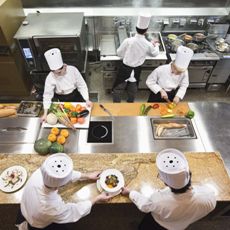
Restaurants need to pay careful attention to ventilation because of the unique nature of their business. It needs to much more efficient compared to other businesses. Maintaining efficient restaurant ventilation helps staff and patrons to be in a comfortable, safe and healthy setting. The quality of the restaurant ventilation can also impact food storage; poorly ventilated areas increase rate of spoiling.
Equipment Needed
Hoods: Ventilation hoods help take the heat, smoke and grease out of the kitchen. Exhaust hoods are put over the hottest parts of the kitchen like a stove or oven.
Proper Ductwork: The proper ductwork allows the grease and smoke to be expelled from the building safely. Additionally, having duct access doors such as flamegard or ductmate will make ductwork accessible to clean so as to keep it safe. These ducts can accumulate quite a bit of grease and grime that increase risk of a fire as well as the air quality and flow through the kitchen.
Exhaust Fans: Exhaust fans take the heat, smoke and grease out of the building, using the hood and ductwork. Further, they also help prevent the grease from the kitchen from being expelled directly into the outside air. These fans can accumulate grease so inspecting and cleaning periodically is important.
Fire Suppression System: The main cause of restaurant fires is cooking grease. For this reason, many local safety codes require restaurant ventilation systems to be accompanied by a fire suppression system. This connects to the hood and helps stop a fire from spreading. Often times these systems are heat activated and even have a manual function to trigger the fire-suppressing liquid.
The Benefits of Quality Equipment
Air Quality Improves Significantly: In a large kitchen a restaurant uses there will be things like grease and smoke in the air, and ventilation helps reduce these health hazards. Employee health will improve since obviously constantly breathing in smoke leads to a variety of health problems. No ventilation system will remove all of the contaminants in the air but it can reduce them to healthier levels for the sake of staff and your customers.
Eliminating Odors: A kitchen that isn’t well ventilated can experience problems with odors if they use raw ingredients. Quality ventilation helps eliminate these odors, not only to make the kitchen more tolerable but also so the patrons sitting near the kitchen will have a better experience, too.
Ventilation Helps Cool The Kitchen: A restaurant’s kitchen is usually going to be the hottest place in the building. With many stoves and ovens running constantly it can become overwhelming for staff. Good ventilation helps reduce the heat immensely to help improve working conditions and staff morale.
Clear up Grease: Grease in the air and on the walls can be quite dangerous. This is bad for the kitchen staff because grease increases the risk of fire spreading easily. There are restaurant ventilation systems that specialize in reducing the presence of grease.
Maintaining Ductwork Extends Life of Ventilation System
Maintenance on the ductwork will extend the life of the entire ventilation system as well as the vent hood. The ducts should be cleaned of grease at least twice a year by a professional— they use special grease-cleaning equipment to go through duct access doors. Avoiding grease buildup over long periods will continue to allow the ducts to stay in use instead of having to purchase replacements. This regular servicing also helps the grease traps, exhaust fan, and overall ventilation stay clean and avoid buildup of grease that can lead to a fire, or damage casing need for a replacement sooner.
The ventilation in a restaurant can have a myriad of impacts on customers and staff. Consider finding a ventilation system that fits your needs as a restaurant owner. Proper ventilation is critical for the happiness and health of patrons and staff, which is priority number 1.
Related posts:






